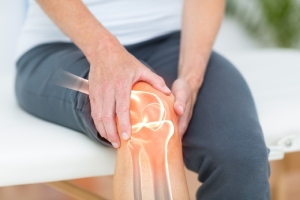From Diagnosis to Pain Relief: 7 Things You Should Know About Arthritis
|
Reading time: 6 minutes
|

Are you one of the over 54 million Americans suffering from arthritis? This common condition is a nuisance for some and debilitating for others.
Arthritis refers to joint inflammation and pain. There are over 100 different types as well as related conditions. Arthritis is physically limiting for many and can take a toll on your physical, financial, and mental health.
Arthritis is common but often misunderstood. If you or someone you love has it, here’s what you should know from diagnosis to arthritis pain relief.
1. A Painful Disease
If you suffer from arthritis, you don’t need anyone to tell you it’s a painful disease. There are many types of arthritis, but three of the most common are osteoarthritis (OA), rheumatoid arthritis (RA), and infectious (septic) arthritis.
Osteoarthritis
Osteoarthritis is the degeneration of the protective cartilage cushioning the ends of your bones. This is the most common form of arthritis and manifests in the spine, hips, hands, and knees.
Some of the symptoms of osteoarthritis include:
- Joint pain
- Joint grating
- Tenderness
- Stiffness
- Decreased range of motion
The risk of osteoarthritis increases with age, but repetitive stress can also lead to OA.
Rheumatoid Arthritis
Rheumatoid arthritis is an auto-immune disorder in which the body’s immune system attacks its own tissues. This causes painful swelling leading to bone erosion and joint deformity.
The inflammation can damage more than your joints. Some people suffer damaged organs such as the eyes, lungs, and heart. Some symptoms of RA include:
- Loss of appetite
- Swollen, warm, and tender joints
- Morning joint stiffness
The exact cause of RA isn’t known, though genetics, bacteria, and viruses are likely culprits. If you suspect arthritis, see a doctor for an arthritis diagnosis and help with pain relief.
Infectious or Septic Arthritis
Torn muscles, sprains, fractures, or infection can all lead to infectious arthritis. An infection traveling through the bloodstream can enter a joint, causing swelling and pain.
Antibiotics are often used for ridding the body of infection. Receiving prompt treatment is the best way to avoid long-term damage to the joints.
If you have a sudden onset of severe joint pain in any of your joints, see a doctor.
2. Many Kinds of Arthritis
Because arthritis is a catch-all term for joint pain and swelling, there are more than 100 types! Arthritis is a complex disease with varying causes as well as symptoms.
3. OA Is a Common Cause of Joint Replacement
Osteoarthritis is the most common form of arthritis because it’s age-related. As we grow older, our protective cartilage breaks down.
The cartilage serves as a barrier between joints which helps them work smoothly without grinding against each other. OA is the most common reason for knee replacement surgery.
OA is also a common cause of hip replacement surgery.
4. You Need to Keep Moving
If your joints hurt when you move, it’s tempting to stop moving. It may seem counterintuitive, but you need to keep moving.
The more you move, the better off you are when it comes to arthritis. You don’t need a ton of exercise, but a sedentary lifestyle will hurt you.
Do you have access to a warm pool? That’s one of the best ways of exercising when your joints hurt. A short walk or bike ride is another good form of exercise for arthritis sufferers.
5. Lower Your Odds of Developing Arthritis
It’s possible to lower your odds of developing arthritis. Eat a healthy diet full of vegetables and fruits.
Avoid sugar! Some research studies reveal that sugar increases inflammation in the body which can lead to arthritis. Sugar also factors into obesity. The heavier you are, the more stress you put on your joints and the protecting cartilage between them.
Avoid eating a diet high in red meat, trans fats, and refined carbohydrates. Limit your intake of alcohol as well.
Regular exercise also helps reduce your chances of developing OA. Exercise helps you keep your weight down and helps with the range of motion in your joints.
Yoga is an excellent exercise. It’s gentle on the joints but increases your flexibility and strength.
6. Risk Factors for Arthritis
Everyone is at risk for age-related osteoarthritis. Studies show that older women are in one of the highest-risk categories. Women suffer OA twice as much as men.
Weight, hormones, anatomy, and sports all play into the risk equation. After menopause, many women gain weight which stresses the joints.
More women engage in sports than previously which increases the risk of injury to the joints. When participating in sports, it’s important to warm up, cool down, and stretch to decrease the risk of injury.
7. Arthritis Is Also a Children’s Disease
Most people associate arthritis with the elderly, but it also affects children. Juvenile arthritis causes most of the same symptoms in children as OA.
As with adults, arthritis is a term for the inflammation, swelling, and joint pain associated with the disease. There are many types of juvenile arthritis.
Some types include:
- Systemic
- Psoriatic
- Polyarticular
- Oligoarticular
- Enthesitis-related
- Undifferentiated
Polyarticular arthritis means there is arthritis in at least five joints, sometimes more. Oligoarticular is arthritis in four or fewer joints.
Systemic arthritis starts with a rash or fever and causes inflammation in other parts of the body on top of the joints.
Psoriasis is a skin condition that sometimes leads to joint pain which is psoriatic arthritis.
Tendons and ligaments attach to bones at the entheses. Inflammation of this area is enthesitis-related arthritis.
Arthritis pain relief is as important for children as it is for adults. If you suspect your child may have arthritis, see a physician.
Arthritis Pain Relief Is Important
For some people, arthritis is debilitating, though for others it’s more of an inconvenience. Either way, arthritis pain relief is important.
Deteriorating cartilage, swollen joints, and inflammation can impact your quality of life. Don’t let arthritis get the better of you.
Avoid a sedentary lifestyle and exercise daily if possible. Avoid sugar and other inflammatory foods and avoid gaining excess weight which stresses your joints.
There’s no cure for arthritis, but medications and other treatments, as well as lifestyle choices, play a role in keeping you comfortable.
Do you need a reputable online pharmacy? Click here for more information.
Information provided on this website is for general purposes only. It is not intended to take the place of advice from your practitioner







